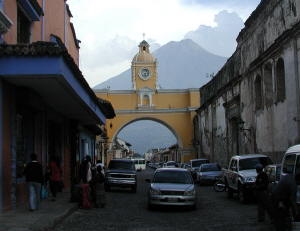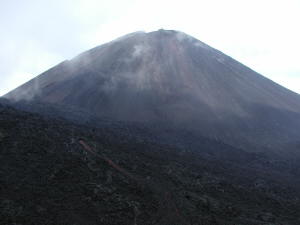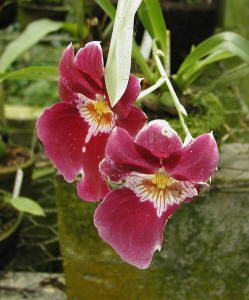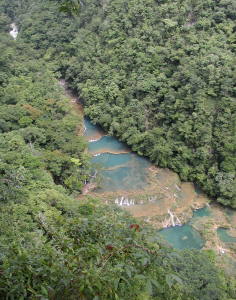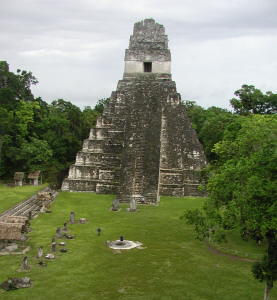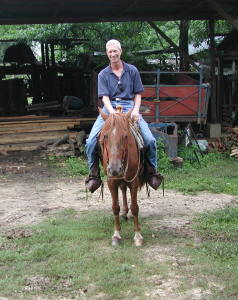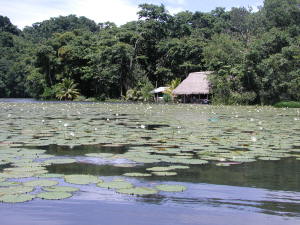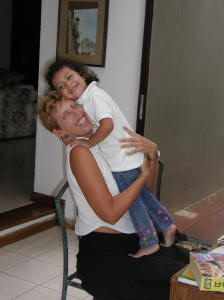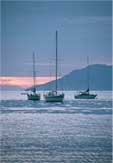
Logbook: Guatemala Inland Travel
July 2 - 21, 2006
After spending two weeks in Spanish school, we went off to explore more of Guatemala. Our route took us from Lake Atitlan to Antigua, then Coban, Lanquin and Semuc Champey, Flores and Tikal, Poptun, Rio Dulce and Livingston, Guatemala City, and then back to El Salvador We traveled by bus, van and boat and visited cities and countrysides, caves and waterfalls, an active volcano and ancient Mayan ruins.
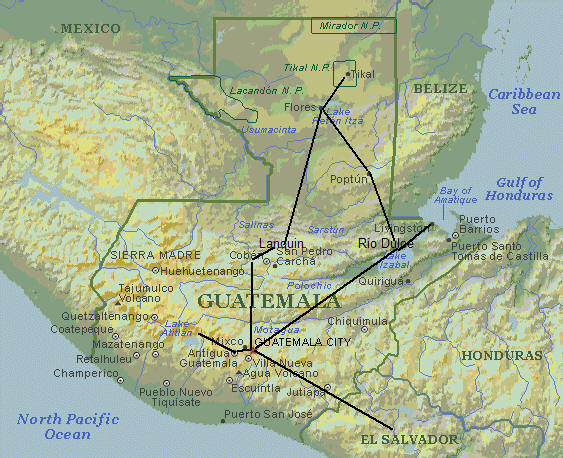
| Antigua, July 2-6.
Antigua is Central America's most famous colonial city. It was founded in 1543 and served as the capital of Guatemala for
233 years. The capital was transferred to Guatemala City in 1776 after
Antigua was leveled by an earthquake in 1773. The town was slowly rebuilt,
retaining much of its traditional character. Antigua was declared a
national monument in 1944, and in 1979, Unesco declared it a World Heritage
Site.
Antigua's population is approximately 40,000; its altitude is 4,950 feet (1500 meters). The weather here was very pleasant - warm days (but not hot) and comfortable evenings. Southeast of the city, Volcan Agua at 12,400 feet (3766 meters) towers over it. Tourism came to Antigua when it started to offer immersion Spanish classes (since 1970), and this city continues to be the leading provider. It presently has 65 Spanish schools serving 1000 students. We did not attend school here, but there are a number of good sights to see in and near this city. When we arrived late on a Sunday afternoon, we were amazed at the number of tourists on the city's central plaza. The feel of the city was quite different from the Mayan village of San Pedro, where we'd spent our previous two weeks. |
|
Our first full day in Antigua was our 7th wedding anniversary (July 3). We spent the day touring the city on foot - wandering into courtyards of the colonial buildings, visiting a few churches, and people-watching from a bench on their central plaza. Antigua has a lot of churches; we counted 27 on a map provided by their tourist office, but some of them are in ruins. We visited only a couple of the churches - their Cathedral de Santiago, which was founded in 1542, but damaged by earthquakes many times and only partially restored; and their Iglesia de San Francisco where Guatemalans offer prayers for the ill at the Chapel of Hermano Pedro, a Franciscan monk who founded a hospital for the poor. After our day of sightseeing, that evening we splurged on a nice dinner to celebrate our seven years of marriage.
Other sights we took in while in
Antigua:
|
|
Additionally, one evening we attended a slide show presentation given by Elizabeth Bell, an American who moved to Antigua with her family in the 1960's when she was 14 years old. Ms. Bell is very active in the city and talked about restoration efforts and steps taken to assure security for tourists.
We also continued to follow the World Cup Soccer Competition, which was into semi-final play at this point.
Coban, July 6-8.
Coban is in the middle of the country, and although we didn't find the city
itself to be particularly attractive, there were a couple of sights to see, and it was a good stop
to break up the travel from Antigua to Lanquin. The town has a population
of 20,000, and with an elevation of 4,350 feet (1,320 meters), and the climate was
pleasant. While here, we toured:
|
|
The hotel where we stayed in Coban had a nice restaurant, which was popular with the locals. One evening, while having dinner there, we noticed the table next to us with two young Guatemalan girls, their mother and grandmother. The young girls kept looking at us and smiling, and so Jan greeted them saying "Hola!" Then, the mother of the girls turned to us, and said "Oh, they speak English." We started talking with them and found out that the mother and girls lived in Salt Lake City. The mother was originally from Coban, and they were back visiting the grandmother. The mother was practically gushing when she said to us - "I love living in the U.S." This was coming from someone who undoubtedly saw some terrible times in Guatemala. Although our country isn't perfect, we definitely appreciate how lucky were are to have been born in the USA.
| Lanquin & Semuc Champey, July
8-10. Most of the folks we met while traveling in Guatemala raved
about Semuc Champey, a series of waterfalls and pools, near Lanquin. El
Retiro, a riverside eco-lodge in Lanquin also came highly recommended. Although most
of the travelers we met along the way were much younger than us, that never seemed to be an issue
(in fact, many were quite impressed with the fact that we lived on a boat). When we arrived El Retiro, however, we felt like we walked into a Spring Break gathering - it was
Party Central. The place was booked, and our first night there, they had a
Mexican buffet dinner attended by 60 people. The music was so loud, it was
hard to talk to anyone. This was definitely not our "scene" - we felt
like chaperones!
The next day, we visited Semuc Champey, which was absolutely beautiful. We had a great day hiking and swimming in the pools. At the mirador overlooking the pools, we met some very nice local ladies who shared some of their tamales with us. Later that afternoon, we watched Italy beat France in the final game of the World Cup. Fortunately, that evening, dinner at El Retiro was a much quieter affair, but we left the next day. |
|
Flores & Tikal - July 11-12. After Lanquin, we headed to the northeastern area of Guatemala referred to as El Petén, where the altitude is lower, the temperatures are hotter, and the land is covered in dense jungle. Our destination was Flores, a town from which we planned to visit the Mayan Indian ruins of Tikal. To get to Flores, according to our guidebook, we needed to take a van to a town called Sayaché, and then take another bus from there. The guidebook left out one detail, though. Sayaché has a river running through it, and no bridge. It was not a problem - just a surprise - as there were boats to transport us across the river. The boats looked like oversized dugout canoes with a motor. There was also a ferry for cars. (Unfortunately, we missed taking photos here.) When we loaded on our boat to cross the river, we apparently had too many people on board because they couldn't get us pushed off the shore, and they had to ask a few people to disembark to lighten the load. Never a dull moment! We eventually made it safely across the river, caught another van and continued on our way.
Flores is a quaint little town on an island in the middle of a lake. It has cobblestone streets and a good selection of restaurants, internet cafes and other shops. Several hotels and travel agencies offer tours to Tikal. This was Jan's second time to visit Flores and Tikal (she was last here in 1992), and she definitely noticed the growth in tourism here.
| The Mayans first settled in the
region of Tikal
around 700 B.C. By A.D. 250, it had become an important and heavily populated
religious, cultural and commercial city. By the mid 500's A.D., Tikal
sprawled over 30 sq. km. and had a population of perhaps 100,000. Tikal's
greatness waned around 900 A.D., part of the unexplained general collapse of
lowland Mayan civilization. Scientific exploration at Tikal began in the
1800's. Tikal National Park was declared a Unesco World Heritage Site in
1979.
We've heard Tikal described as the "mother of all ancient Mayan ruins", a description we find quite appropriate. Tikal contains thousands of ruined structures, many of which have not yet been excavated. Its Great Plaza with the twin temples rising over 40 meters (130 feet) is quite impressive. Another attraction of Tikal is its setting deep in the jungle. The plazas have been cleared and temples uncovered and partially restored, but as you walk from one plaza to another, you walk beneath the jungle canopy. The jungle hosts a variety of wildlife - howler monkeys, many species of birds, tree frogs and lots of other animals (and bugs). It's a beautiful setting. Since the jungle wildlife tends to be more active in the early morning or evening, we opted to take a sunrise tour to Tikal offered at our hotel. We had talked to others who had done this type of tour and really enjoyed it. Before we signed up, we talked to the tour booking agent and told him we didn't want a tour with a lot of people, and he assured us that if there were more than 20 on the tour, there would be two guides. That sounded reasonable to us, and we paid our money. |
|
The bus picked us up at 3:30 a.m., and it was an hour ride to Tikal from Flores. We hiked to and climbed one of the temples to watch the sunrise over the jungle canopy, but unfortunately, it was a cloudy morning, and there wasn't much of a sunrise. We were also disappointed that the tour booking agent lied to us about the number of guides for the group. We had 33 people on the tour, and only one guide. As our "herd" of tourists tramped through the jungle and gabbed while waiting for the sunrise, we saw very little wildlife, and the howler monkeys only howled for about 30 seconds. (Others told us they heard howler monkeys for over half an hour on their sunrise tours.) Our guide - "Little Cesar" - was one of the worst tour guides we've ever had. If he knew much about the history of Tikal, he didn't share it with us. Unfortunately for "Little Cesar", we'd been to other ruins, so we had other tours for comparison, and this one just didn't measure up.
Fortunately, the ruins of Tikal are so grand that a lousy tour and guide didn't spoil it for us. After a couple of hours with Little Cesar and the herd, we ventured off on our own to explore. An area that really caught our attention was called the Plaza of the Seven Temples, which is still being excavated. When we got back to our hotel, we got out our guidebook and read more about the history of Tikal. (We didn't think to take the book with us because we thought the guide would tell us some of the history.)
Although Jan had visited Tikal 14 years ago, she totally enjoyed revisiting this sight, and would go back again. The increase in tourism has made Tikal more easily accessible, including wooden stairs added to some of the temples to make them easier to climb. On her previous visit, she remembers going up the side of one of the bigger temples on a ladder. Although there are more tourists now, Tikal hasn't been overrun or spoiled. This is truly a spectacular sight to see and one we would highly recommend.
Poptun & Finca Ixobel, July 13-17. At the recommendation of someone we met in Antigua, we stopped at Finca Ixobel, an eco-lodge outside of Poptun, as we headed south from Flores. Finca is Spanish for "farm," and this is a working farm where they grow their own vegetables and produce their own eggs. We were reminded of this country's violent past when we read in our guide book that Michael Devine, an American who previously operated Finca Ixobel, was murdered in 1990.
The finca is set in a rural area, with lots of wildlife, and we enjoyed listening to bird songs and cicadas as we fell asleep at night and woke in the morning. Just outside the window of our room, there were a couple of hummingbird nests, and Jan would lay in bed in the morning and watch the mother hummingbird sitting on her eggs. This was also a buggy area, and it was the first time either of us slept under mosquito netting, which we actually found rather cozy.
Finca Ixobel offered a number of activities - hiking, caving, horseback riding, river tubing. All of the activities were guided. We took advantage of a couple of the activities:
- Ixobel Cave (Cueva Ixobel). There are several cave tours available in Guatemala, but this one seemed to suit us best - a big wide-open cave where one doesn't have to climb through tight spaces or swim through parts of it. Although we know there are some truly beautiful caves in this world, spelunking doesn't top the list of our favorite things to do. Rich got lost in a cave for several hours when he was younger, and Jan, although not really claustrophobic, prefers wide open spaces. Our tour involved a 45-minute hike to and from the cave, and it was just the two of us and a guide named Manuel. This area had some heavy rains recently (typical of the rainy season), and the hike to and from the cave was incredibly muddy and slippery. The mud really took its toll on our hiking boots, but fortunately, neither of us slipped and fell in the mess. We walked through some pretty countryside on our way to the cave and watched a guy clearing a field with his machete - what a lot of work! The cave was very large, and the stalactite and stalagmite formations were beautiful. The guide pointed out a few tarantulas and a number of bats hanging upside-down, and Jan was reminded why she doesn't really like caves!
Finca Ixobel was a great place; it was kind of like being at a camp for a few days. The ambiance was nice, we met interesting people, and we had lots of fun. |
|
| Rio Dulce & Livingston 7/17-20.
From Poptun, we continued further south to the Rio Dulce ("Sweet
River"), which is reputed to be a good cruising area and has a number of
marinas. The Rio Dulce flows into the Caribbean at Livingston, Guatemala.
(Only a short segment of Guatemala touches the Caribbean Sea.) The village
of Rio Dulce lies about 20 km inland from Livingston. When we arrived at
the village of Rio Dulce, we caught a boat to Livingston. The trip to
Livingston took about an hour and a half and it was a pretty ride passing by
islands of trees filled with birds, an inlet filled with lily pads, an area with
a thermal spring and finally passing through a steep-walled gorge called Cueva
de la Vaca ("Cave of the Cow").
Livingston is only reachable by boat - there are no roads leading to this town. One of the locals told us that the Guatemalan president recently offered to build a road to this city, but the residents declined because they felt it would bring more crime. |
|
Livingston's residents are primarily Garifuna - black Guatemalans who are descendants of Africans brought to the New World as slaves. After a revolt on the Caribbean island of St. Vincent in 1795, the British brought the Garifuna to the Honduran island of Roatán. From Roatán, the Garifuna people spread out along the Caribbean Coast, from Belize to Nicaragua, and intermarried with the Carib Indians, Maya and other races. Although we found the locals to be very friendly in most other parts of Guatemala, the feeling was very different here in Livingston. We were so used to saying hello to everyone walking down the street, that we found it strange (and somewhat unsettling) to try to greet someone and receive no response. We've been told by other cruisers not to expect the Caribbean locals to be as friendly as the Mexican and Central Americans on the Pacific Coast, so perhaps this was our introduction.
The recommended site to see from Livingston is Los Siete Altares (the Seven Altars), which is a series of freshwater falls and pools about 5 km (3 miles) north of Livingston along the shore of Bahia Amatique, a Caribbean bay. Because robberies have occurred at the Seven Altars in the past, our guidebook recommended taking a guided tour. One of the restaurants in town offered a walking tour of the city, with a short canoe trip and then a walk along the beach to the Seven Altars.
The day of our tour dawned rainy, but we donned our plastic ponchos and went for it. When we arrived for the tour, we were told that the English-speaking guide drank too much the night before and wasn't coming to work, so they were sending us with Pablo, their Spanish-speaking guide. Pablo told us he is Garifuna/Mayan mix; he was in his mid 20's, married with a couple of kids, and a nice enough guy (but missing his two front teeth - we didn't have the nerve to ask him what happened to them!) Another young American couple from the Pacific Northwest joined us on the tour, and we sloshed through the streets of town, to the graveyard where the first person buried was under a tree, to a mirador (viewpoint) from which we saw nothing because it was overcast and raining, then through some more mud to the canoe trip down a river to the beach, where we finished the walk to the Seven Altars. Our guidebook said there's an option to take a boat trip to the Seven Altars, but it's better to walk to experience the natural beauty, which we found to be an interesting recommendation. The beach we walked along to the Seven Altars was the trashiest beach we've ever seen. We assume the trash washed down the Rio Dulce to the Caribbean (exacerbated by the rainy season) and then washed back up on the beach. All of the trash was plastic - mostly plastic bottles and styrofoam containers - and there was a thick layer of it on the beach, probably three feet wide. It made us want to never again buy anything in a plastic bottle, but unfortunately, that's pretty much impossible.
The Seven Altars' beauty paled in comparison to Semuc Champey or Agua Azul (in Chiapas, Mexico), but it was pretty, and the pools were refreshing since the sun finally decided to come out. Pablo walked us all the way up to the seventh altar, where he showed off by jumping from the top of the fall into the pool. (Pablo was definitely still a kid at heart!) The other young guy joined him, but we stuck to swimming in the pools.
The next day, we returned to the village of Rio Dulce, walked around a bit, checked out some of the marinas and bought bus tickets for our return to Guatemala City.
Guatemala City 7/20-21. When we left Rio Dulce for Guatemala City, we were starting our trek home. At this point, we had been away from Slip Away for five weeks - the longest we've ever been off the boat - and we were eager to go home and especially sleep in our own bed. The bus ride to Guatemala City was about 5 hours. We arrived mid afternoon and needed to spend the night and catch a 6 a.m. bus the next morning back to San Salvador.
Because Guatemala City has a reputation for having some dangerous areas, we asked for a hotel recommendation from King Quality bus lines (the one we'd be taking back to San Salvador). King Quality is a luxury bus line, and their station is in a very nice part of Guatemala City. They told us they knew of a "Guest House" close to their station where we could spend the night at a reasonable price. When we arrived in Guatemala City from Rio Dulce, we took a cab to the King Quality station, and the Guest House picked us up and took us two or three blocks away to their location.
| The Guest House was actually a beautiful huge house that had been converted into
a hotel of sorts. The manager kept apologizing to us that she only had a
small bedroom for us, but it was the nicest room we'd slept in since we arrived
in Guatemala, and the bathroom (which we shared with other rooms) was huge -
with a shower, jacuzzi tub and two sinks. Although Jan had taken a shower
that morning, she took another one that night because it was such a nice
bathroom! The Guest House manager was a delightful woman named Evelina, who spoke fluent English and French, as well as her native Spanish. She told us that for years she worked as a tour guide and led tours throughout Guatemala. Evelina was formerly married to an American soldier, and she had two grown children; however, she also had a younger daughter - four-year old Katya, from Nicaragua, whom she adopted. Evelina told us that she met Katya's mother in Chiapas, Mexico, when Katya's mother was trying to get the U.S. At the time, Katya was one month old and had pneumonia, and the mother "gave" the baby to Evelina. Katya is a ball of energy, and since she meets new people every day, she isn't a bit shy. She took an instant liking to Jan, and they spent hours playing together that afternoon. Although we had not looked forward to spending the night in Guatemala City, we wished we could have stayed two to have more time to speak with Evelina about her travels through the country during their civil war. |
|
Return to El Salvador 7/21. We left the Guest House bright and early the next morning to catch our 6 a.m. bus back to San Salvador. Evelina got up and made us coffee (some of the best we'd had in Guatemala) before their driver took us to the bus station. We were back in San Salvador late morning, and we grabbed some lunch and then took a taxi to Terminal Sur, the bus terminal where we caught our local bus (another two hours) back to Slip Away in Bahia del Sol.
Some final thoughts...
We would classify our travel in Guatemala as "adventure" travel. We were on a budget, so we usually took local transportation and stayed in backpacker-type hotels. We used the "Lonely Planet - Central America on a Shoestring" as our guide.
Local transportation was either a chicken bus or a "microbus", which was generally a twelve-passenger van. A couple of the vans we traveled in felt like they were fairly new, but others felt like they might breakdown at any minute. We quickly learned that when we had twelve people in a twelve-passenger van, it was not full. We often traveled two or three hours with 18 to 24 people in a van. Since the seats in the back of the van didn't offer much room for Rich's long legs, we usually tried to get the front van seat or sit up front with the driver. The drivers were usually accommodating in letting us sit up front with them since we were both a head taller than most of the locals.
With the exception of our last night in Guatemala City and the two weeks in San Pedro when we stayed with a family, we stayed in budget hotels. We did not stay in dorms - we always had our own private room - but we often shared a bathroom. Our cheapest room was in Livingston ($8.66/night) - that place left a lot to be desired. We joked that a Lonely Planet description of "clean" means the floors have probably been swept in the past month or so. The most we paid for a room was $21 at El Retiro, and the room there was big and nice, but Rich thought the bathroom smelled musty. The smell must have appealed to a couple of really big bugs that hung out on the bathroom walls. We had to get used to the bugs and other creatures that came along with visiting a country that is mostly jungle - like the time Jan went into the "Jungle Shower" at Finca Ixobel and had to nudge a frog out of her way.
Although there were some discomforts, we generally took them with a grain of salt (sometimes it required a pound of salt), and we felt the benefits definitely outweighed the discomforts. We saw some really beautiful places and interesting sights. Sometimes the scenery as we were riding along in the bus was breathtakingly beautiful - especially in the highlands.
One of the best parts of the trip was the interesting people we met along the way - a young British couple in the final weeks of their trip around the world and a South African couple just starting theirs; a couple of young Germans who were living and working in Quetzaltenango (he as a fireman, and she as a teacher); a young French Canadian couple - she was a professor and he was a student of Sociology, and she was also an accomplished sailor and lived in Africa for a couple of years when working on her Masters thesis; a group of five American friends, one of whom was blind; a group of middle-aged folks from Columbus, Ohio, who were working on a Habitat for Humanity house; an Austrian family traveling together - mom, dad (a recently retired teacher) and their two daughters who were in their early 30's - last year they hiked the Inca trail in Peru; numerous young Israelis, most of whom had recently completed their service with the Israeli army and were taking some time off before starting University studies; lots of teachers spending the summer traveling, and many, many more. We especially remember a conversation one evening with a couple of young Israelis, one of whom was very worried about her family because they lived close to the Lebanese border, and the conflict with Hezbollah had recently started.
As we mentioned previously, most of the travelers we met were young - many in their early 20's - backpacking and visiting several countries in Central America. One day we were talking with some of the younger travelers about the fact that there weren't many other travelers our age, and they told us that they couldn't imagine their parents traveling in this way. If one's idea of "roughing it" is a three-star hotel, this isn't the place to come!
We were particularly touched to see how many of these young people were spending some of their travel time doing volunteer work - teachers working with kids living in the dump or orphanages, others helping to build houses, libraries or other structures. Kids like this give us hope for a bright future.
We spent a total of five weeks in Guatemala and saw a lot of the country, but there's much more to see. We have many treasured memories from these travels.
